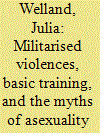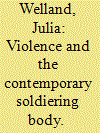|
|
|
Sort Order |
|
|
|
Items / Page
|
|
|
|
|
|
|
| Srl | Item |
| 1 |
ID:
160119


|
|
|
|
|
| Summary/Abstract |
In recent years there has been a ‘turn’ to thinking about war through the experiences of those touched by it. While this scholarship has generated numerous important insights, its focus has tended to remain on wars’ violences, those responsible for enacting them, and the effects of such violence. In this article, the experiences of pleasure and joy in war that simultaneously take place are placed centre stage. Drawing on three war novels, the article tracks three recurring themes of pleasurable and joyful experiences related to war: bodily pleasures, the ‘togetherness’ of war, and moments of joy that escape war’s reach. Through this focus, war is shown to work across a range of affective registers and as never totalising or universalising in its experience. The article argues that paying attention to joy and pleasure can work to displace war as a focus of analysis, directing attention instead to the experiences of those who live through war and how they survive, sustain, and resist it.
|
|
|
|
|
|
|
|
|
|
|
|
|
|
|
|
| 2 |
ID:
123382


|
|
|
|
|
| Publication |
2013.
|
| Summary/Abstract |
In recent years numerous reports of prisoner abuse and other militarised violences by British troops stationed in Iraq and Afghanistan have emerged. Drawing on two such incidents - the abuse of detainees at Camp Breadbasket and the murder of Baha Mousa - this article seeks to locate such violences on a continuum that can be traced back to the ways in which British soldiers are trained. Following on from a burgeoning feminist literature on militarised masculinities, and using Avery Gordon's epistemology of ghosts and hauntings, I suggest a conceptual and methodological intervention into the subject that resists generalised stories and the mapping of 'hard' borders. Focusing on the myths of asexuality and discipline that emerge from, and reinforce, the gendered discourses of basic training, I conduct a 'ghost hunt' of the haunting spectres that have attempted to be exorcised from these myths. Making visible these ghost(s) and tracing their (violent) materialisations through multiple sites and across a continuum, militarised violences - in all their ranges - begin to be made explicable.
|
|
|
|
|
|
|
|
|
|
|
|
|
|
|
|
| 3 |
ID:
157102


|
|
|
|
|
| Summary/Abstract |
This article asks what is the significance of making the soldiering body (hyper)visible in war. In contrast to the techno-fetishistic portrayals of Western warfare in the 1990s, the recent counterinsurgency campaign in Afghanistan witnessed a re-centring of British soldiering bodies within the visual grammars of war. In the visibility of this body, violences once obscured were rendered viscerally visible on the bodies of British soldiers. Locating the analysis in the War Story exhibition at the Imperial War Museum, London, the article details two moments of wartime violence experienced and enacted by British soldiers, tracking how violence was mediated in, on and through these hypervisible soldiering bodies and the attending invisibility of ‘other’ bodies. The article argues that during the Afghanistan campaign, soldiers’ bodies became not just enactors of military power but crucial representational figures in the continuance of violent projects abroad and their acceptance back home.
|
|
|
|
|
|
|
|
|
|
|
|
|
|
|
|
| 4 |
ID:
163712


|
|
|
|
|
| Summary/Abstract |
Veterans have long sought to make sense of and capture their wartime experiences through a variety of aesthetic means such as novels, memoirs, films, poetry, and art. Increasingly, scholars of international relations (IR) are turning to these sources as a means to study war experience. In this article, we analyze one such sense-making practice that has, despite its long association with war, largely gone unnoticed: the military tattoo. We argue that military tattoos and the experiences they capture can offer a novel entry point into understanding how wars are made sense of and captured on the body. Focusing on a web archive—War Ink—curated and collected for, and by, US veterans of Iraq and Afghanistan, we analyze how tattoos perform an important “sense-making” function for participating veterans. We focus on three recurring themes—loss and grief, guilt and anger, and transformation and hope—and demonstrate how military tattoos offer important insights into how military and wartime experience is traced and narrated on and through the body. The web archive, however, not only enables a space for veterans to make sense of their war experience through their tattoos, it also does important political work in curating the broader meaning of war to the wider public.
|
|
|
|
|
|
|
|
|
|
|
|
|
|
|
|
|
|
|
|
|